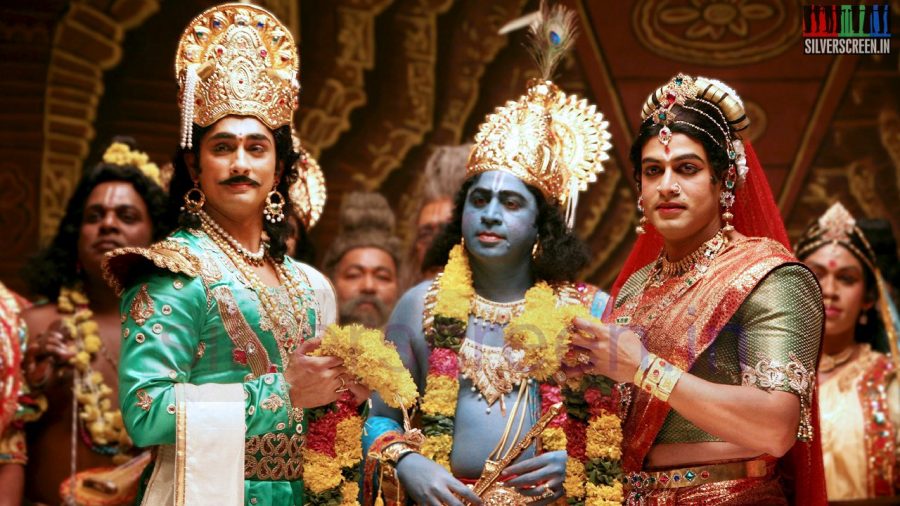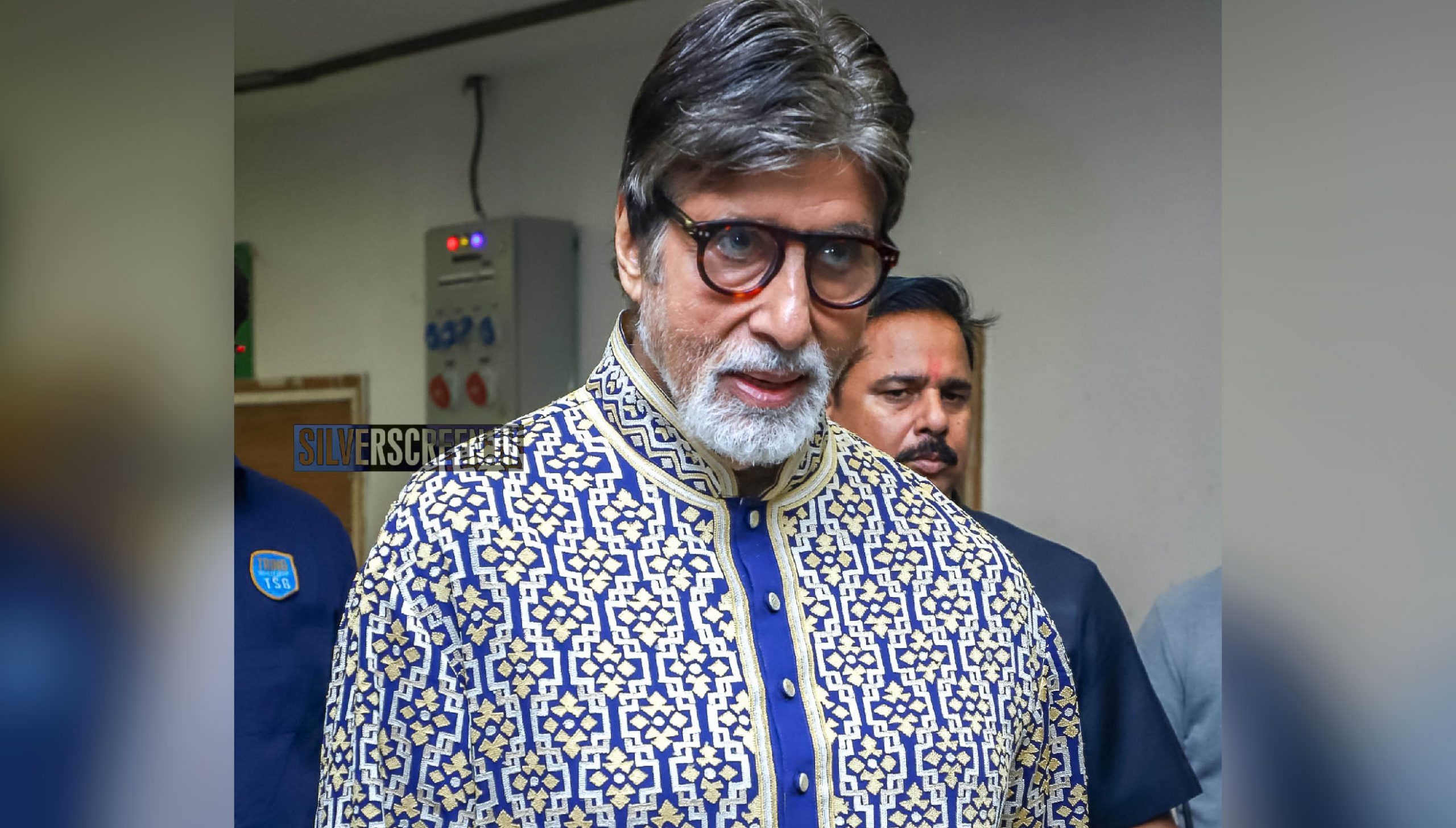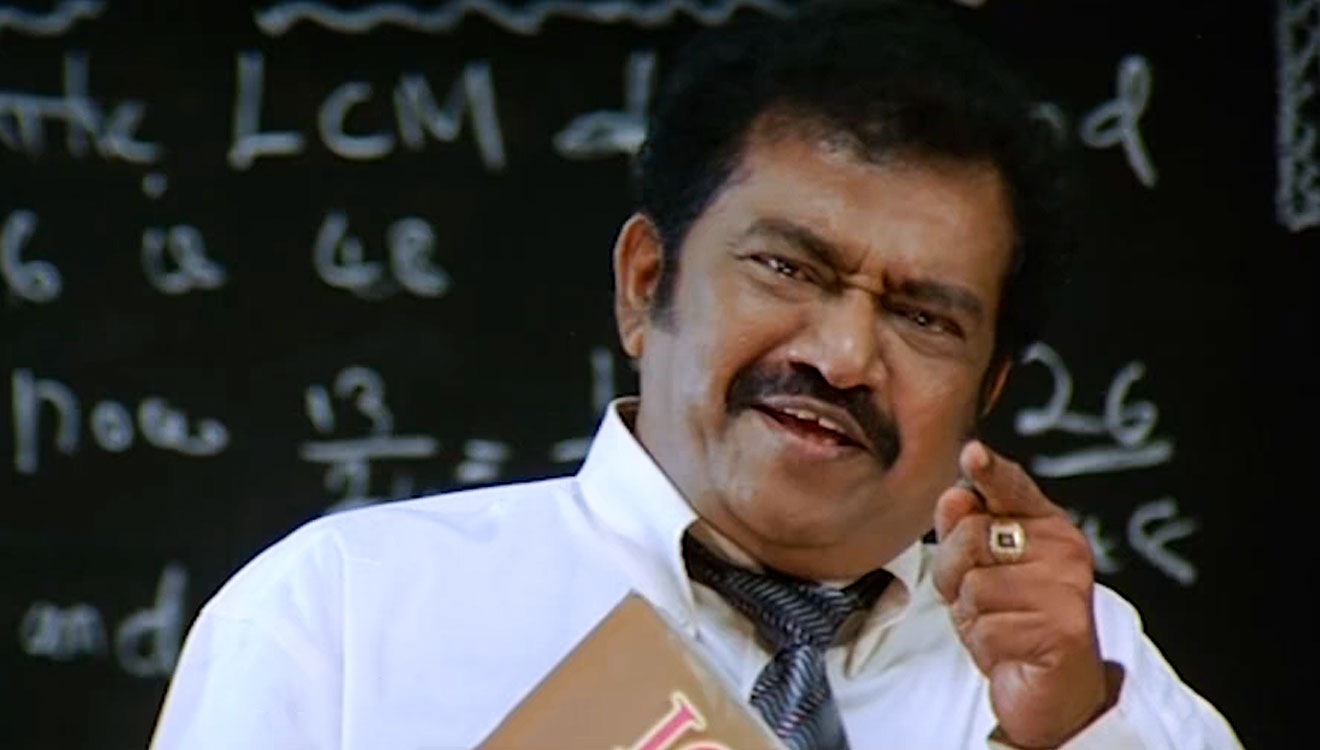Vasantabalan might believe in communist ideals, but his sets for Kaaviya Thalaivan are extravagant. His colours are vibrant; the reds run deep, the costumes charmingly old world, and the music fascinating.
It’s pure theatrical magic. For a while.
Credits – fashioned in quaint theatre style – roll against a brilliant red curtain set to a vibrant mix of harmonica and trumpets. And then, a beloved old-world motif graces the closing screen – a Raja Ravi Verma oleograph of Saraswathi.
*****
Kaaviya Thalaivan begins with a tribute to yesteryear theatre greats. It mentions Shenkottai Gangadhara Aiyar Kittappa, replete with an old stage photograph of him dressed as Andal; it mentions KB Sundarambal – unrecognizable in the garb of a British soldier – both gender reversed in their theatre finery, and it also briefly pays tribute to Sankaradas Swamigal – an acclaimed Tamil playwright, hailed as the father of modern Tamil theatre. But it doesn’t stop there. Kaaviya Thalaivan brings them to life, marking its characters with a distinct trait or two. Vadivu (Vedhika), whose role is inspired by Sundarambal, is mostly seen in those beautiful sungudis while Thalaivankottai Kaliappa Bhagavathar (Siddharth) is a fiery young idealist, quite similar to Kittappa.
*****
For a premise set in the pre-independence era, Vasantabalan opts for splashes of red in every frame. While some are quite discernible – a vivid red sari, a bullock cart with a blood-red screen or a table cloth in crimson – during others, it takes a practiced eye. A ruby earring, the spoke of a wheel, a bright red twine onto which a bead is strung, or quite simply, a fold of red tucked in between a stack of white dhotis in the almirah. In sharp relief against the muted, sepia-toned background. It’s deliberate, Vasantabalan had revealed in our interview earlier – for a dash of old-world flavor.
But despite the painstaking detailing, vestiges of modern life are evident somehow. It’s probably just the way certain words are pronounced, or quite simply, the absence of those errant lines on the screen. It’s still there all the same; the proof of half a century of progress.
*****
Kaaviya Thalaivan offers a glimpse into the world of old theatre; a berth to observe and live among a drama troupe. It is set in a gurukulam; helmed by an imposing and authoritative guru – Sivadasa Swamy (Nasser) – a contrastingly humane vaathiyar, and their set of boys who have known no other home. It records their lives, especially the kinship between two favourite proteges of Sivadasa Swamy – Kaliappa (Siddharth) and Gomathy Nayagam (Prithviraj) – and their subsequent rivalry.
It also captures the spirit of theatre; Sivadasa Swamy’s school is a place where impromptu dialogue rehearsals are commonplace; nobody bats an eyelid when Vadivambal suddenly emerges in queenly silks and ornaments and utters some fiery lines. They only cheer and applaud in genuine, tearful appreciation.
*****
Vasantabalan invests some time in crafting individual characters – he carves them out with precision – rather than relationships. During an instance, Kaali and Gomathy watch a senior artiste perform the role of Raavanan. As he bursts forth on his demonic exploits – all aggression and spittle – Gomathy and Kaali – in their garb of Rama and Lakshmana – in a fascinating display of the divide between the real and the imaginary – watch from behind the folds of a curtain. Gomathy is clearly in awe of the performance; he desires to be the next rajapart, and there-in lies his inspiration. Kaali, though, on the other hand, looks on dispassionately; indifferent to the proceedings. He remarks, unmoved; Raavanan has to instill fear. Not awe.
Vasantabalan brings us another moment. As the reigning rajapart leaves, Sivadasa Swamy has to choose another from among his proteges. Gomathy, who performs first – as Soorapadhman – shows naked aggression. He bellows every word. Kaali, though, plays it low. His growls don’t rise beyond a timbre, but he’s menacing nevertheless. Gomathy seethes in jealousy. Vasantabalan paints him in red as well.
While Kaali, on the other hand, is milky white.
*****
Recommended
Post interval, things turn dramatic. As dramatic as a movie inspired by theatre can get. Vadivambal is always tearful and obsequious (wanting to bear Kaali’s child when she was clearly scorned), Kaali distressingly forgiving when it concerns Gomathy, and the latter more vengeful (there are no clear indications of kinship as the movie claims, save a few boyhood anecdotes).
Vasantabalan’s films are no laughing matter, indeed. They are deliberately sober. And this one – quite like his previous ventures – is no different. It just leaves you with a sense of unease.
*****
The Kaaviya Thalaivan review is a Silverscreen original article. It was not paid for or commissioned by anyone associated with the movie. Silverscreen.in and its writers do not have an advertising relationship with movies that are reviewed on the site.



